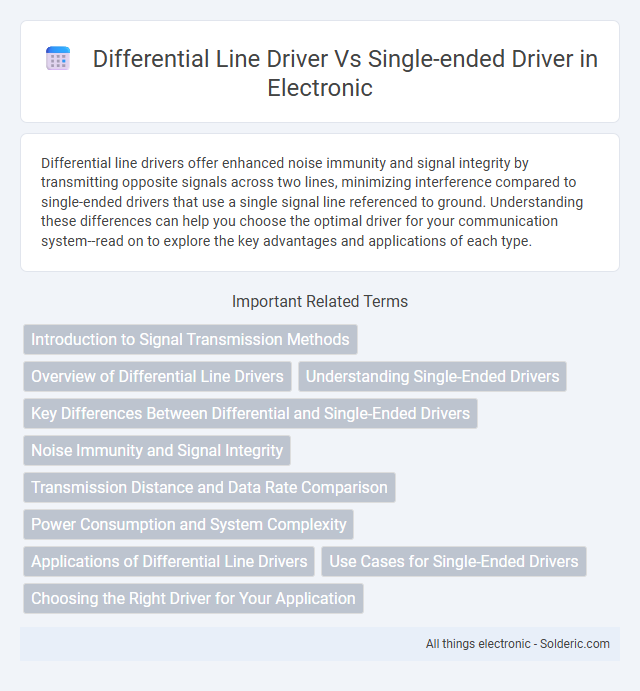Differential line drivers offer enhanced noise immunity and signal integrity by transmitting opposite signals across two lines, minimizing interference compared to single-ended drivers that use a single signal line referenced to ground. Understanding these differences can help you choose the optimal driver for your communication system--read on to explore the key advantages and applications of each type.
Comparison Table
| Feature | Differential Line Driver | Single-Ended Driver |
|---|---|---|
| Signal Type | Two complementary signals | Single signal referenced to ground |
| Noise Immunity | High, cancels common-mode noise | Low, susceptible to noise |
| Signal Integrity | Better over long distances | Degrades with distance and noise |
| Voltage Swing | Lower per line but combined effective | Full voltage swing on single line |
| Power Consumption | Typically higher due to two lines | Lower, single line output |
| Complexity | More complex driver and receiver | Simpler design and architecture |
| Common Applications | High-speed data, long cable runs, RS-422, RS-485 | Short distance, low speed, TTL signals |
| Cost | Higher due to additional components | Lower cost implementation |
Introduction to Signal Transmission Methods
Differential line drivers transmit signals using two complementary voltages, enhancing noise immunity and reducing electromagnetic interference compared to single-ended drivers, which send signals referenced to a common ground. This method improves signal integrity, especially over long distances and in noisy environments, by allowing the receiver to detect the voltage difference between the two lines. Single-ended drivers, while simpler and cost-effective for short-range or low-speed applications, are more susceptible to noise and signal degradation.
Overview of Differential Line Drivers
Differential line drivers transmit signals using two complementary voltage lines, reducing electromagnetic interference and enhancing signal integrity over long distances compared to single-ended drivers that use one signal line referenced to ground. They offer improved noise immunity by canceling common-mode noise, making them ideal for high-speed data communication and industrial environments. Key applications include RS-485 and LVDS interfaces, where differential signaling ensures reliable and efficient data transmission.
Understanding Single-Ended Drivers
Single-ended drivers transmit signals through a single conductor referenced to a common ground, making them simpler but more susceptible to noise and electromagnetic interference. They are commonly used in applications where cost and simplicity are prioritized over noise immunity, such as consumer audio devices and basic control systems. The signal integrity in single-ended drivers decreases significantly over long distances or in high-speed data transmission due to ground potential differences and external interference.
Key Differences Between Differential and Single-Ended Drivers
Differential line drivers transmit signals using two complementary voltages, which improves noise immunity and signal integrity over long distances compared to single-ended drivers that use a single voltage reference. Differential drivers generate lower electromagnetic interference (EMI) and maintain higher signal-to-noise ratios, crucial for environments with high electrical noise. Your choice between these drivers impacts communication reliability, with differential drivers preferred for robust data transmission in industrial and high-speed applications.
Noise Immunity and Signal Integrity
Differential line drivers offer superior noise immunity by transmitting signals over two complementary lines, effectively canceling out electromagnetic interference and common-mode noise. In contrast, single-ended drivers are more susceptible to noise since they rely on one signal line referenced to ground, which can degrade signal integrity over long distances or in noisy environments. Choosing a differential line driver enhances your system's signal integrity by maintaining cleaner, more stable data transmission, especially in high-speed or industrial applications.
Transmission Distance and Data Rate Comparison
Differential line drivers significantly outperform single-ended drivers in both transmission distance and data rate by effectively reducing electromagnetic interference and crosstalk, enabling reliable communication over longer cables typically exceeding 100 meters at high speeds. Single-ended drivers are limited to shorter distances, often under 15 meters, due to susceptibility to noise and signal degradation, restricting their maximum data rates to comparatively lower MHz or low Gbps ranges. Differential signaling supports data rates beyond 10 Gbps while maintaining signal integrity across extended cable lengths, making it ideal for high-speed communication protocols like USB 3.1, HDMI, and Ethernet.
Power Consumption and System Complexity
Differential line drivers consume more power compared to single-ended drivers due to their use of two complementary signals for improved noise immunity and signal integrity. System complexity increases as differential drivers require additional wiring and circuit components to manage balanced transmission, which can impact PCB layout and design costs. Your choice depends on whether lower power consumption or enhanced signal quality and noise resistance are prioritized in the application.
Applications of Differential Line Drivers
Differential line drivers are widely used in high-speed data communication systems such as Ethernet, USB, and HDMI interfaces due to their superior noise immunity and signal integrity over long cable runs. They are essential in industrial automation and instrumentation networks where robust signal transmission in electrically noisy environments is critical. Compared to single-ended drivers, differential drivers enable higher data rates and reduced electromagnetic interference, making them ideal for applications requiring reliable and accurate signal transmission.
Use Cases for Single-Ended Drivers
Single-ended drivers are commonly used in short-distance data transmission where signal integrity and noise immunity requirements are lower, such as in consumer audio equipment, simple sensor interfaces, and single-ended TTL logic circuits. These drivers are cost-effective and simpler in design, making them ideal for applications with limited budget constraints and minimal electromagnetic interference. They perform well in environments where signal lines are short and the likelihood of noise-induced errors is minimal.
Choosing the Right Driver for Your Application
Differential line drivers offer superior noise immunity and signal integrity by transmitting complementary signals over paired conductors, making them ideal for long-distance or high-speed data transmission. Single-ended drivers, with their simpler design and lower cost, suit shorter distances and less noise-sensitive applications where signal degradation is minimal. Evaluating your application's distance, noise environment, and data rate requirements will help determine whether a differential line driver or single-ended driver best meets your performance and budget needs.
Differential line driver vs single-ended driver Infographic

 solderic.com
solderic.com